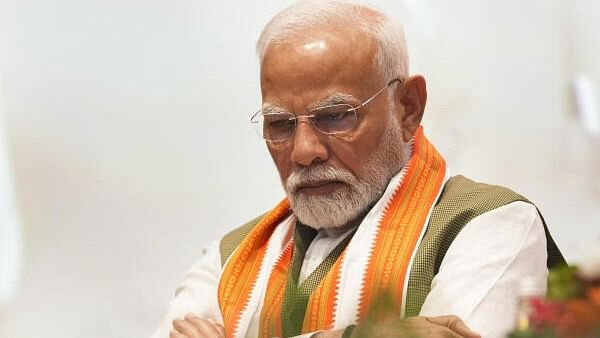
Prime Minister Narendra Modi during the launch of BJP's membership campaign 'Sadasyata Abhiyan 2024', in New Delhi.
Credit: PTI Photo
In Jammu and Kashmir, Congress leader Rahul Gandhi claimed, “We have finished Modi psychologically. I sit in front of him in Parliament and I know his confidence is gone.”
Can this be dismissed as mere rhetoric? Several indicators suggest that Modi is aware of being on unstable ground and increasingly worried about a slide in his public image.
In the upcoming state elections, he is not the mascot of the party as in the past.
The nervousness of the Bharatiya Janata Party (BJP) is most evident in J&K. Union Home Minister Amit Shah’s reaction to the Congress-National Conference pre-electoral alliance in the Union Territory, that this could push the region into an "era of unrest and terrorism", spoke volumes. The resurrection of Ram Madhav, who had been left in the wilderness four years ago, to handle the J&K election also shows how desperate the BJP is.
Old party hands are being denied tickets, and those who have jumped ship from other parties are accommodated as party candidates. It seems that the election campaign in the UT would be based on Article 370, under the misconceived notion that it would be a magnet for voters.
In Haryana, the BJP appealed to the election commission to postpone the polling date (which it obligingly did). The party was apprehensive that its urban middle-class voters may not stay home to vote over the long weekend.
In Haryana, there is more discussion about Bollywood actor Kangana Ranaut’s comments on the farmers’ movement than about the Modi government’s programmes. After successfully relying for a decade on non-Jat politics, the BJP is casting about for Jat votes. Wags have remarked that the self-proclaimed non-dynastic BJP today is dependent on the descendants of the three Lals — Bansi Lal, Devi Lal, and Bhajan Lal.
Bansi Lal’s daughter-in-law Kiran Chaudhary defected to the BJP from the Congress just weeks ago, and has been accommodated in the Rajya Sabha. Her daughter Shruti Choudhary; Devi Lal’s son Ranjit Chautala; and Bhajan Lal’s son Kuldeep Bishnoi, daughter-in-law Renuka Bishnoi, and grandson Bhavya Bishnoi are the others who the party hopes will pull in the votes.
Although Maharashtra elections are due only in November, Modi is already apprehensive of the outcome. It would have been unthinkable before the Lok Sabha polls that he would apologise for any administrative misdemeanours. His abject apology after the collapse of the Shivaji statue (which he had inaugurated in December) is being seen as an attempt to woo the Marathas. “I bow my head at his feet and apologise to my deity,” he declared after visiting the site instead of asking for a thorough investigation of the disaster.
There was no comparable apology for leaks developing in the roof of the Ram temple at Ayodhya after the first rains and waterlogging because of poor construction and drainage issues. Nor did he apologise for the 14-km-long Rampath which collapsed at a dozen spots.
That Modi wants to skip any negativity attached to his brand is evident in his avoidance of his home state of Gujarat which is struggling with devastating floods. Neither he nor his trusted Lieutenant, Amit Shah, have found time to visit the state, treating a national calamity as a local issue.
The prime minister’s international travels perhaps are a good excuse to stay away from crucial state elections. It is Brunei one day, and Singapore the next. When campaigning will be at its height in Haryana and J&K, he will be visiting the United States from September 22 to 26 to attend the UN General Assembly (UNGA) in New York.
Besides addressing the UNGA, Modi is also scheduled to address Indian diaspora in a ‘Modi and US: Progress Together’ event on September 22 at the Nassau Veterans Memorial Coliseum, a multi-purpose indoor arena in Uniondale, New York, which seats 15,000 people. Note that the event theme is about ‘Modi and US’ and not ‘India and US’.
These events will keep Modi out of state election campaigns for nearly a full week in its peak season.
It is doubtful whether the Indian diaspora rallies abroad or photo-ops with world leaders can be leveraged any longer back home. But they do provide an excuse for his absence.
Joining these dots, the picture one gets is of Modi who does not want to be associated with possible election defeat in the states. The stigma of possible defeat can then be blamed on a local leader — a Nayab Singh Saini, a Devendra Fadnavis, a Babulal Marandi or Arjun Munda.
While the BJP may not be able to write off Modi just as yet, the party seems to have realised that he is past his peak, and his brand value has eroded. Through his latest actions, Modi himself has shown that he is on the backfoot.
Other forces are asserting themselves in his political spectrum especially the Rashtriya Swayamsevak Sangh (RSS) which seems to have taken the weakened prime minister head on over the caste census. While Modi ruled out holding a caste census, his ideological parent, the RSS has come out openly in its favour with the caveat that “it should only be done to address the welfare of those communities and should not be used as political tool for electioneering”.
What these straws in the wind suggest is that Rahul Gandhi could have touched upon a raw truth — Prime Minister Narendra Modi may have formed an alliance government to ensure a third term, but he must feel the pain of defeat within.
(Bharat Bhushan is a Delhi-based journalist.)
Disclaimer: The views expressed above are the author's own. They do not necessarily reflect the views of DH.